The Cause Of The Crimea Bridge Explosion
Of the four theories circulating regarding the cause of the Crimea Bridge explosion, the physical evidence available has now eliminated three.
At 6:03 AM local time on October 8th, there was a large explosion on the Kerch Strait Bridge connecting the Crimean Peninsula with Russia. This explosion resulted in the destruction of one of the two parallel road decks, as well as severely damaging the other. A train carrying flammable fuel was set ablaze by the blast causing significant damage to the railway bridge as well.
Initially there were four theories as to what could have been the cause of the explosion. As we have progressively gotten more images and video from both the attack itself and the aftermath, the evidence has effectively ruled out three of the theories, leaving one remaining as the probable cause.
The four initial theories were:
A watercraft of some kind detonating below or next to the road deck.
A Ukrainian SOF team placing explosives on the bridge.
A missile strike, with the theory focusing on the use of ATACMS.
A civilian truck being used as a VBIED detonating on the road deck.
Watercraft Detonation
The theory that the explosion could have been the result of a watercraft detonating below the bridge initially gained traction due to a surveillance video from the time of the explosion showing the appearance of a wave under the bridge just prior to the explosion. This wave was then theorized by many to be the wake from an watercraft travelling under the bridge before detonating.

This part of the theory can be easily debunked as the video shows the wave appearing under a bridge span that remained undamaged after the explosion. As can be seen from the colored still below, the bridge piers for both the road bridge and the rail bridge are constructed with the same distances between. The wave visible on the video travels between the purple and orange highlighted pair of bridge piers.
Images from after the explosion show that the area between the purple and orange bridge piers is undamaged by the explosion and the explosion happened between the orange and green piers. This rules the wave out as having been from a watercraft traveling under the span before detonating.
Wind data from the time of the explosion at Kerch Airfield about 11km north west of the bridge shows winds at the time coming from east-north-east at around 19km/h. This wind direction corresponds to the wind hitting the bridge at a perpendicular angle from the side of the road bridge. This can help explain the appearance of the wave prior to the explosion.
This wind direction can be confirmed from the video showing the blast, where smoke and debris moves from the road bridge towards the rail bridge. The wind continued to come from the same direction throughout the day, which can be confirmed by later images showing the fire and smoke from the burning rail cars blowing away from the road bridge.
Images later released of the span at the center of the explosion from below further help disprove the theory that an explosion occurred underneath this span. From below there are no indications of blast damage from below, be it from pressure or fragmentation. The bridge piers can also be seen to be without apparent blast damage.
The left span is almost entirely without damage visible from below and many fragile components, including the cable supports that run along the span are undamaged. Had the blast originated from below with enough force to collapse the parallel span, these would undoubtedly have suffered major blast damage.
The collapsed span does have damage to the cable supports, but this appears to be damage resulting from the collapse and bending of the span rather than blast damage. The two main girders supporting this span bow outwards showing signs that a large pressure wave from above pressed down on the road deck until the span snapped from the pressure and collapsed.
A variation of the watercraft theory also making rounds involves a watercraft detonating while being next to the bridge instead of underneath the span. Here much of the same evidence of lack of damage to the underside of the bridge can be used to debunk it. Especially the visible bowing outwards of the main girders on the collapsed section. Had the explosion happed beside the bridge these would have had blast damage bending them in the same direction instead of away from each other.
Additional evidence against this theory can be found on the top of the road deck. Here we can see that the guardrail posts on the outer edge of the collapsed span, that would have been closest to an explosion beside the bridge, are bent outwards at a near 90 degree angle. This indicates that the blast came from the direction of the road deck and not from beside the bridge.
At this time, the combination of all these pieces of evidence from the scene of the explosion rule out the watercraft theory as being a realistic and probable cause of the explosion. Too many factors are inconsistent with this theory or specifically show the opposite of the damage expected if this was the cause.
Special Operations Force Sabotage
In the immediate aftermath of the explosion there several high profile individuals theorized that the explosion could have resulted from Ukrainian special forces placing explosives on the bridge to bring it down.
This theory has the most pieces of evidence pointing against it. Firstly, surveillance video footage from the time of the blast shows that the explosion generated a fireball at least 100m wide, large enough to engulf both road bridge spans and the rail bridge. A fireball of this magnitude would require an amount of explosives that is simply not realistically feasible for a special forces team to carry and then proceed to hide on the structure.
Secondly, as can be seen on all images showing the aftermath of the explosion, the collapsed span snapped near the middle before collapsing. This would be a realistically unfeasible and impractical location to place the amount of explosives needed to create the explosion seen on the videos. Were they to place this enormous amount of explosives, placing it on a bridge pier would be more feasible.
Thirdly, had this been a SOF demolition, sabotaging only a single span of the road bridge during an operation as risky as this one would be makes little logical sense. Had a special forces team been inserted hundreds of kilometers behind enemy lines, the rail bridge would have been the logical target due to its importance in Russian logistics.
These reasons make this theory incredibly unlikely and at this time I would rule it out completely as the possible cause of the explosion.
Missile Impact
A missile impact has been speculated by many as being the cause of the explosion. Given the distance from the frontline, the only missile that could realistically be been used in the attack is the MGM-140 ATACMS. As of now, there is no conclusive evidence of ATACMS being in the possession of the Ukrainian military. Ever since the first shipments of M142 HIMARS arrived in Ukraine the U.S. government has continuously denied having supplied any ATACMS missiles to Ukraine.
The main piece of physical evidence pointing squarely against ATACMS being the cause of the explosion is the size of the explosion. The ATACMS uses a 500lb WAU-23/B warhead, which is identical to the WDU-18/B used in Harpoon anti-ship missiles. This warhead contains 216lbs of Destex (Desensitized Tritonal) which has a a TNT relative effectiveness of 1.05. This means 216lbs of Destex is equivalent in energy to 226.8lbs of TNT. This is at least a factor of 10 less than would be required to cause the explosion seen on the video. In an interview with Finish media, retired Major Myka Tyry of the Finish Armed Forces estimated that 1000-2000kg (2200-4400lb) of explosives would be required to cause the explosion seen in the video and damage. This also rules out the not yet operational Ukrainian Hrim-2 ballistic missile which has a warhead approximately twice the size of ATACMS.
The distance from the Crimean Bridge to the current frontlines would also require an ATACMS missile to be fired exceptionally close to the frontline, which would severely endanger the M142 HIMARS or M270 firing the missile. Firing the ATACMS this close to the frontlines at night would probably also have alerted Russian forces to the launch allowing time for attempted air defense intercepts. There were no reports of any such attempted intercepts on the night of the attack.
Truck VBIED
A truck loaded with explosives is the official cause stated by the Russian authorities, which has caused many people to flat out refuse to believe this cause of events due to previous Russian lies. At this time though, this is the theory that has the most supporting evidence.
Firstly, we have significant scorching on the surface of the road deck indicating that the explosion originated from the top of the road deck where the truck was located at the time of the explosion. From this angle we can also see that the other two collapsed spans have given way at the expansion joints as a result of the first span collapsing and them not being able to stand up to the resulting axial loading.


The final frame on the security footage prior to the detonation shows that the front of the truck is directly parallel the lamp post at the center of the span at the time of the explosion. The span is 70m in length and the lamp posts are 35m apart. Given the approximately 20m length of the truck, with would place the rear axles of the trailer about 1/3 of the way across the span at the time of the explosion factoring in its forward momentum.
From drone images of the collapsed span, we can see that the section buckled and broke 1/3 of the way across the span. This is approximately where the rear axle of the truck’s trailer would have been at the time of the explosion.
Looking at the image the image from below the road deck we can see the indications of pressure damage from above with the bowing out of the main girders as previously mentioned. Additionally we can see a hole in the the bridge in the right hand lane, directly where the rear axles of the trailer would have been located. I speculate that this hole was created by the force of the explosion shooting the rear axles downwards with enough force to penetrate the road deck.
Another image of the collapsed section from the other side show additional evidence of the road deck being bent by the pressure wave from the blast before snapping and collapsing. This image also shows the hole in the road deck possibly caused by the rear axles being blown through it. Additionally there are many small pieces of fragmentation damage in the road deck just behind the hole.
This image shows the damage to the span running parallel to the collapsed span. Here we can blast pressure damage to the intact span corresponding to an explosion in the right hand lane of the collapsed span. The blast pressure has bent the side of the intact span inwards and downwards away from where the truck would have been located at the time of the explosion.
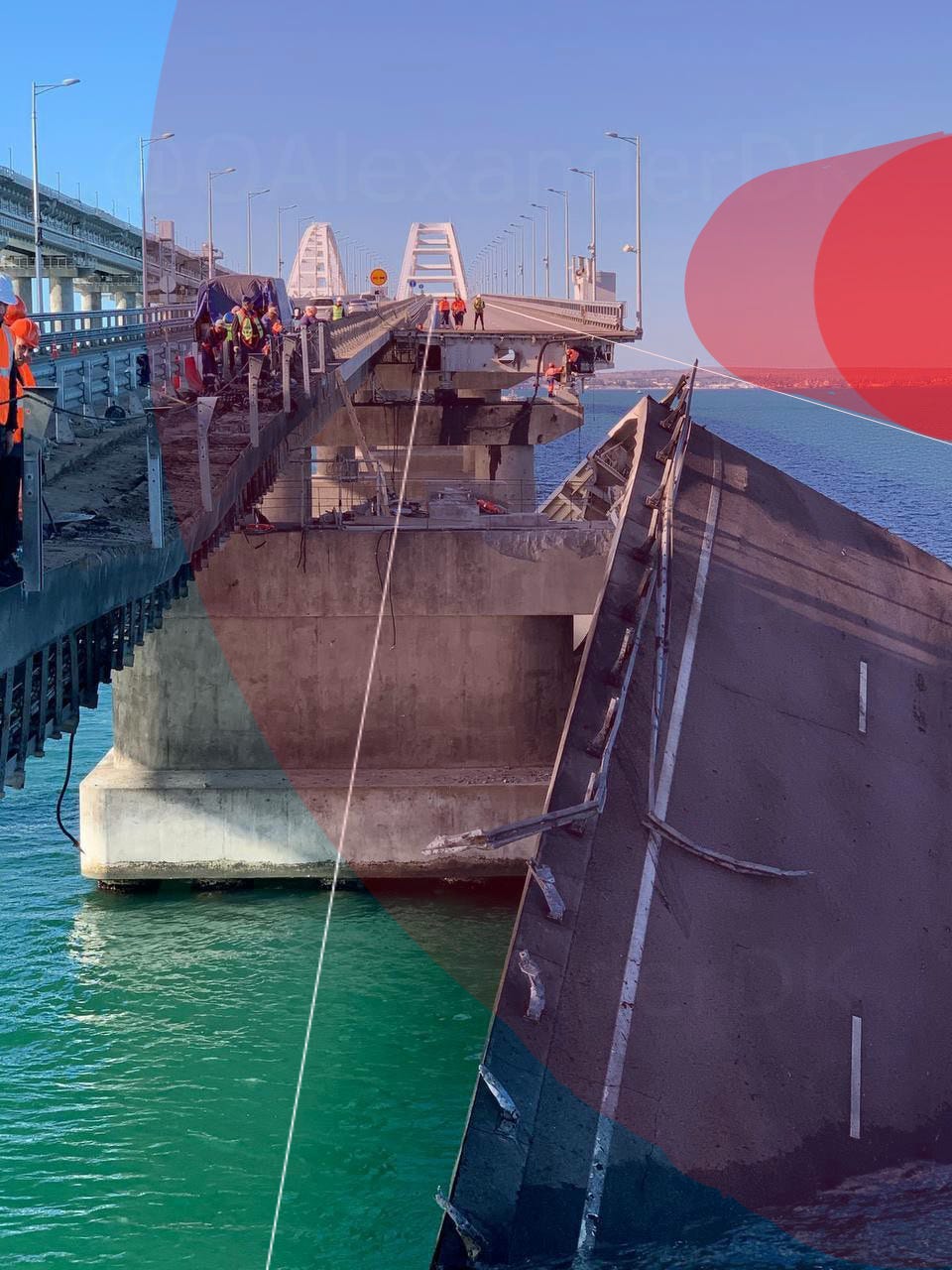
Furthermore, the same image shows that the guardrail posts nearest the source of the explosion on the collapsed span are all blown directly away from the location of the truck at the time of the blast.
In the video below a significant amount of smaller debris is visible on the intact span after the explosion, as well as significant scorching.
One piece of debris from the blast has been been IDed as the front axle of an International ProStar truck. This is the same model of truck as was seen in CCTV footage receiving almost no security check before being allowed to cross the bridge.
On the debris it was possible to identify the stub axle and the frame horn identical to that on an International ProStar truck. This confirms that the truck in the CCTV images is the same one as was at the center of the explosion.
The front axle was thrown almost 100m from the location where the truck was on security footage just prior to the explosion. It landed on the intact span further along the bridge at the location where the expansion joint gave way causing the second span to collapse. This location and the fact that it is just the front axle means that the explosion happened behind the front axle of the truck with enough force to completely annihilate the truck.
As a result of the culmination of all the evidence we have at this time, I feel fairly certain in the conclusion that the explosion on the Crimea Bridge was caused by the detonation of a large volume of explosives loaded onto a truck. All pieces of photographic evidence from the scene of the explosion corroborate the truck bomb theory.
I remain open to any evidence to counter this cause, but at this time it is the only remaining theory without significant evidence debunking it as a probable cause.







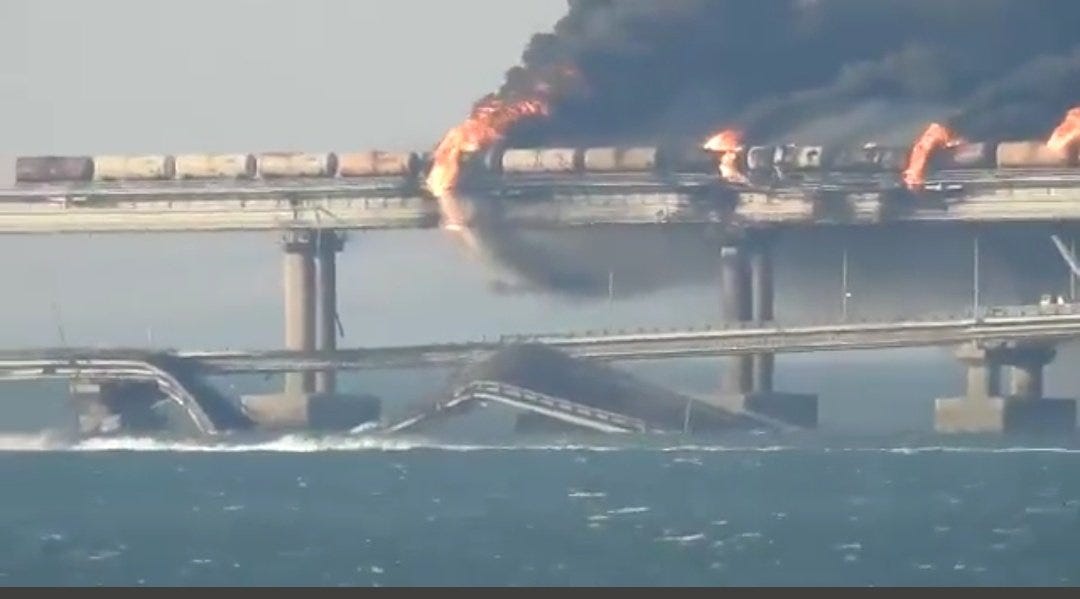



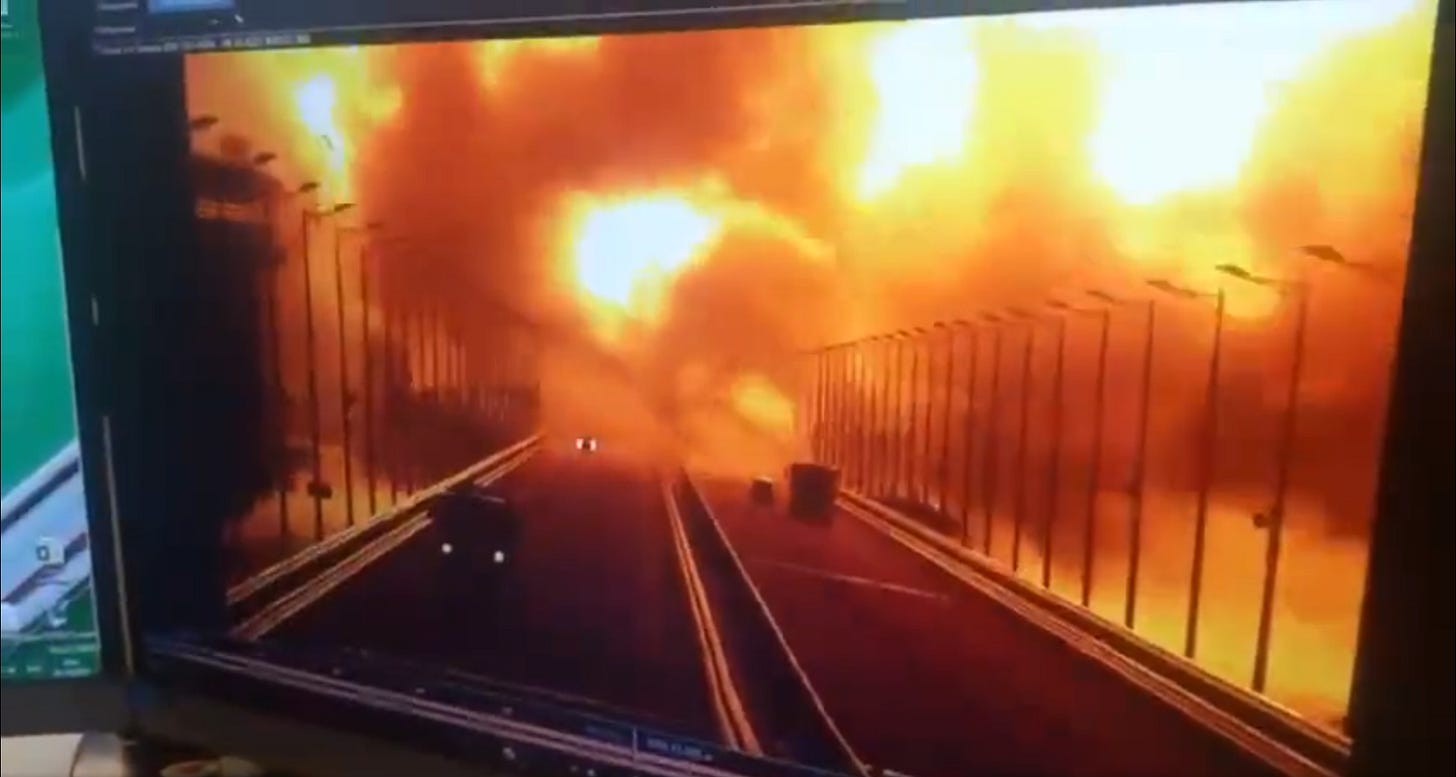

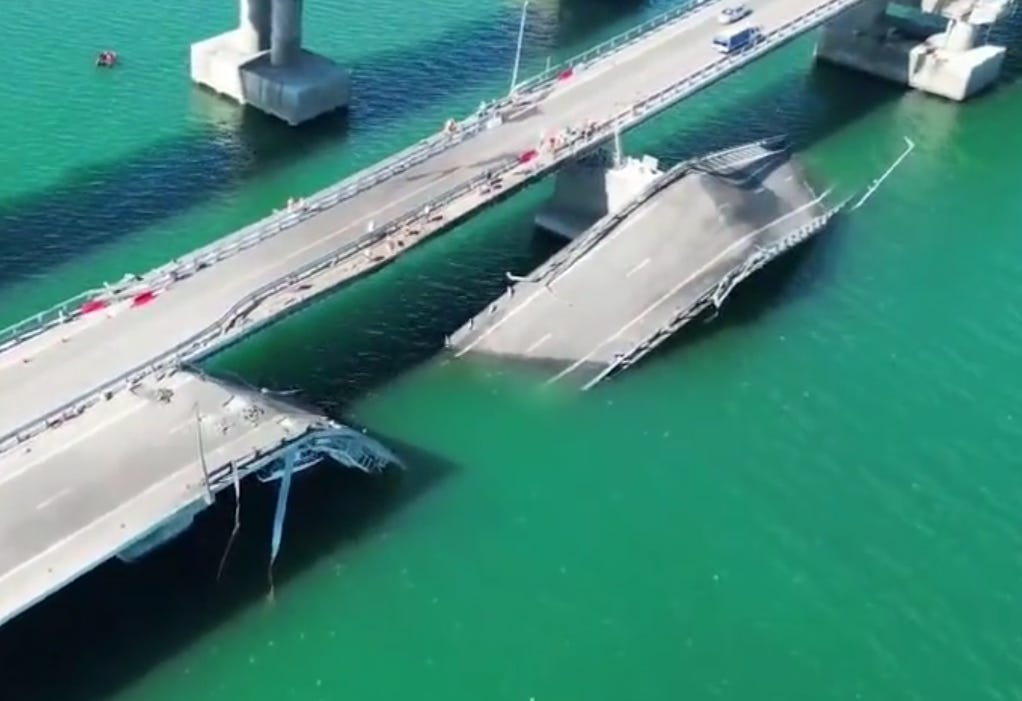

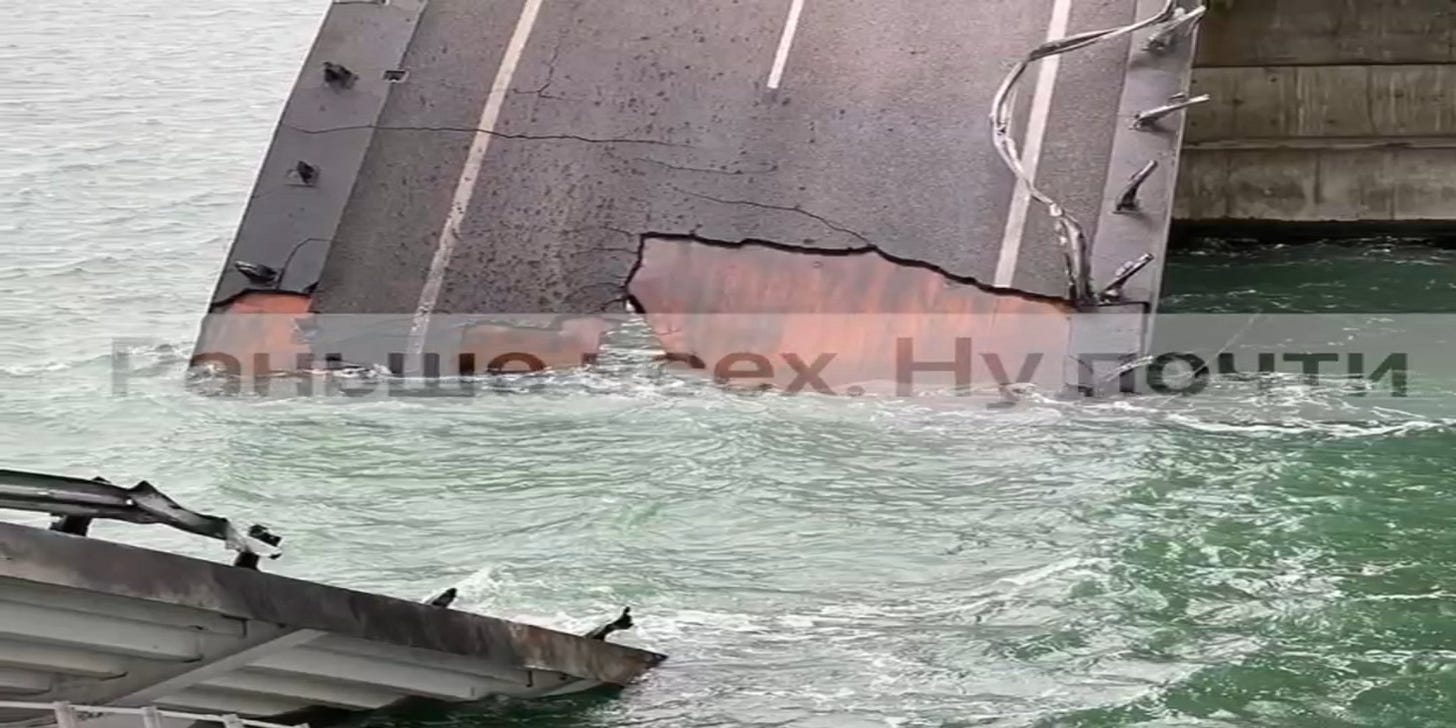


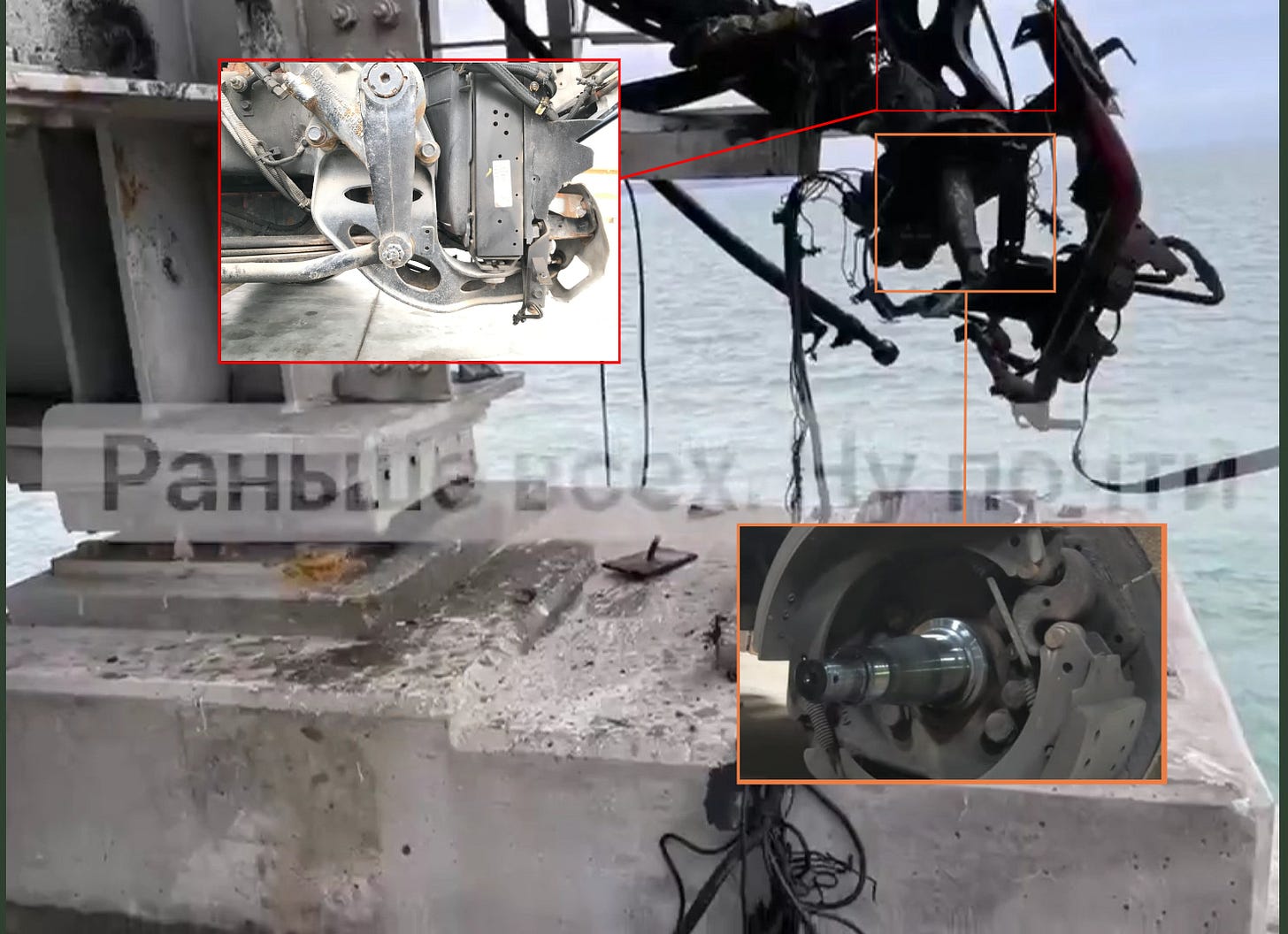

Hi Oliver, this was a fascinating read. However, I have seen several images that purport to show the truck still intact after the explosion happened. It is my understanding that they look at the videos frame by frame, which appears to show the flash of the explosion and the truck unharmed. Could you comment on these? Is there any veracity to them?
Very interesting analysis. Is there any theory about the driver and how the explosion was initiated? Driver unaware and explosion detonated remotely killing the driver? Driver fled the truck prior to explosion? Suicide mission?